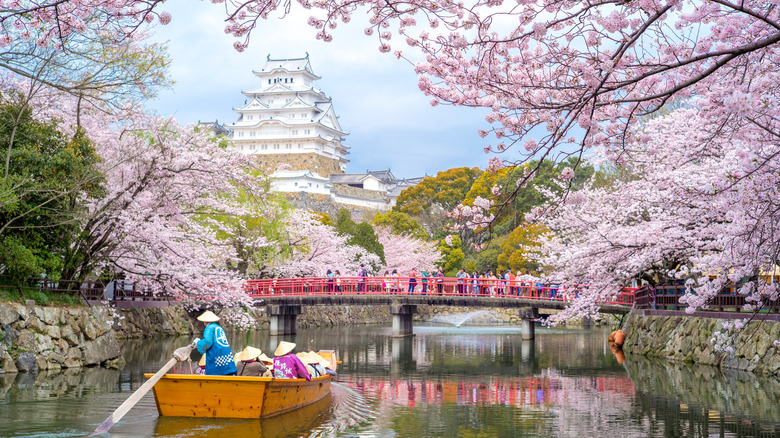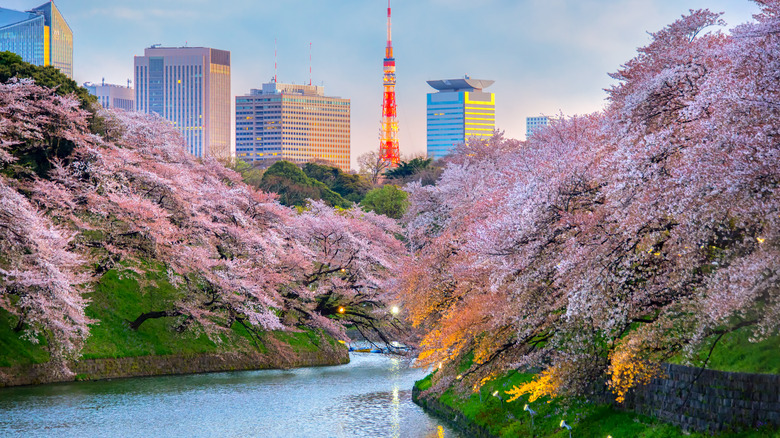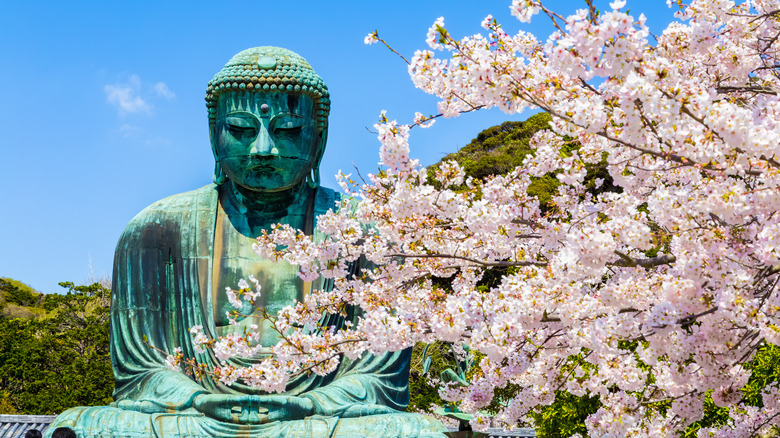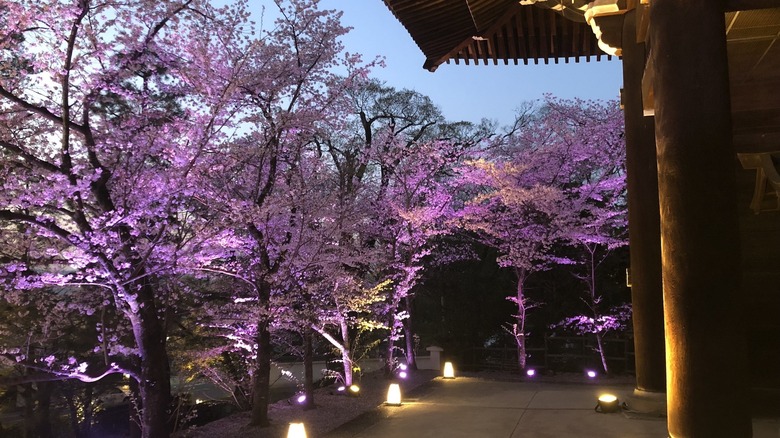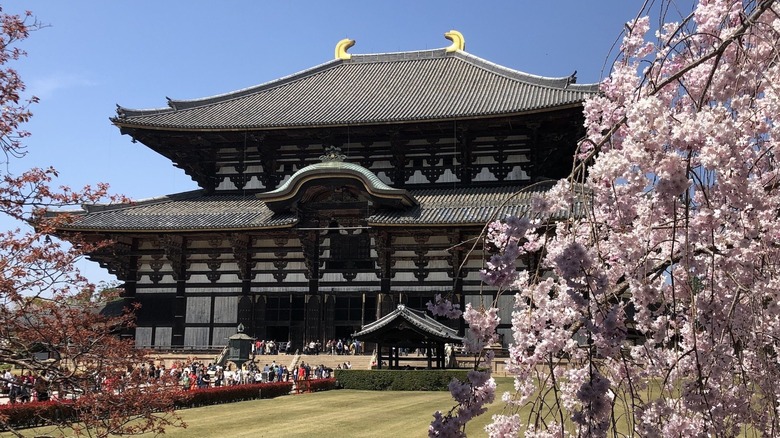The Best Spots To View Gorgeous Cherry Blossoms In These Two Popular Regions Of Japan
If you're flying into Japan for cherry blossom season, there's a good chance you'll land in one of two regions: Kanto or Kansai. The country's three busiest international airports are all located here. Narita International Airport and Haneda Airport, otherwise known as Tokyo International, are gateways to the capital and the rest of the Kanto region (including Japan's second-largest city, Yokohama). Kansai International Airport services the area where other big cities like Kyoto, Osaka, and Kobe are clustered together in the same railway network. Wherever you're headed in Kanto or Kansai, there are plenty of places to see the sakura, or Japanese flowering cherry, in bloom.
Though the blooming period only lasts about two weeks, the cherry blossoms give spring tourism a multi-billion-dollar boost across Japan. As the unofficial national flower (the semi-official one is the imperial chrysanthemum), it's an indelible part of the culture here. Even the cherry blossoms in Washington, D.C., can be regarded as an extension of that since they were a gift from the City of Tokyo in the early 1900s.
Hanami (the common Japanese term for cherry blossom viewing) can be tricky when you've planned your trip months beforehand. The timing of the peak bloom varies depending on the place and weather each year, so it's good to watch the cherry blossom forecast and keep your travel itinerary fluid. It also helps to have backup plans in mind and know your many options with spots like these in Kanto and Kansai.
Places to see cherry blossoms in Tokyo
One picturesque cherry blossom viewing spot in the heart of Tokyo is Chidorigafuchi. Part of the Imperial Palace moat, it has a walking path and pier where you can ride rowboats with blossoms sloping down the banks. Though it tends to get crowded with picnickers, Ueno Park is another popular spot with convenient access to multiple museums, plus a zoo with two rock-star giant pandas.
Just two stations away on the Yamanote Line, in Nippori, is Yanaka Cemetery, which provides a quieter atmosphere and an appropriate reminder of life's fleeting nature amid the short sakura bloom. Shinjuku Gyoen has a nice green lawn filled with cherry trees, while the riverside flowers of Sumida Park will put you near Sensō-ji Temple. In Inokashira Park, you can board a swan boat for cherry blossom viewing near the Ghibli Museum.
Rikugien Gardens is known for its seasonal illumination of an almost 50-foot shidarezakura (weeping cherry tree) at night. The Tokyo Midtown complex has a promenade of a hundred cherry trees that light up pink, and some of its restaurants have terraces with a view of the blossoms by day or night. The trees of the Meguro River also draw visitors before and after dark, and that's where you'll find Tokyo's branch of the Starbucks Reserve Roastery, one of only six in the world. Alas, the sakura Frappucino season begins early and is usually finished by the time the actual sakura petals open.
More Kanto spots: Yokohama, Kamakura, and Chiba
Yokohama is a city just as fabulous as Tokyo, and that includes its cherry blossom viewing options, such as the pond and pagoda backdrop of Sankeien Garden. To see some well-known city landmarks juxtaposed with cherry trees, stroll along Sakura-dori in the "harbor of the future," Minato Mirai. Yokohama Landmark Tower, once Japan's tallest building, is further visible from the cherry-blossom-filled Kamonyama Park, which overlooks Minato Mirai. If you grab some to-go lunch in Chinatown, you can walk over to Yamashita Park and picnic among cherry trees along the water.
In the seaside town of Kamakura, you'll see one Instagrammable cherry tree beside the famous Great Buddha statue at Kōtoku-in Temple (a place Barack Obama visited more than once). For a fuller view of cherry blossoms, get back on the Eno-den railway to Kamakura Station and visit the nearby Shinto shrine, Tsurugaoka Hachimangū. It has a long approach that will take you down the middle of a beautiful, cherry-tree-lined avenue called Dankazura.
Chiba Prefecture, which neighbors Tokyo to the east, is home to the world's two best-rated Disney parks, where you might catch sakura blooming in front of Cinderella Castle. For a more traditional view of Japan, try the Bōsō Peninsula, where cherry trees surround the reconstructed Tateyama Castle in Shiroyama Park. The Japan Cherry Blossom Association ranks three other sites in Chiba — Mobara Park, Shimizu Park, and Izumi Nature Park — among the top 100 in Japan.
Places to see cherry blossoms in Kyoto and Osaka
In Kyoto, the road to cherry blossom bliss is paved with stones along the Philosopher's Path. It's a scenic, 1.25-mile, canal-length walk from the Silver Pavilion, Ginkakuji, down to the brick aqueduct of Nanzenji Temple. The sakura-lined tracks of the Keage Incline, a former railway, are only about a 10-minute walk from Nanzenji. On the subway — which helps you avoid the long lines for Kyoto's overcrowded buses — it's a straight shot from Keage Station to the cherry trees of Nijō Castle.
Chion-in Temple, Maruyama Park, and the Gion Tatsumi Bridge area are also within walking distance of each other. Like Nijō Castle, they each do sakura light-up events at night. Chion-in is notable for its massive main gate, while Maruyama Park has another big weeping cherry tree as its centerpiece. Gion is the geisha district, though some of its back alleys are now off-limits due to the paparazzi tendencies of tourists. As the official posters say, "Mind your manners when in Kyoto."
Over in Osaka, you'll find cherry blossoms in Tempozan Park, named for its bayside hill, which is actually the smallest mountain in Japan. The Tempozan Bridge and Tempozan Giant Ferris Wheel tower over it, and Osaka Aquarium Kaiyukan is nearby. With over 4,000 cherry trees encircling its wheelchair-accessible main tower, Osaka Castle Park is perhaps the city's premiere hanami destination. Locals also flock to Kema Sakuranomiya Park to see almost 5,000 cherry trees growing along the Okawa River.
More Kansai spots: Nara, Kobe, and Himeji
From Kyoto and Osaka, you can take the train to other cities in Kansai, like Nara, Kobe, and Himeji. Hiroshima isn't the only place where hundreds of deer roam free. Nara Park also has them, along with plenty of cherry trees. You can feed the deer senbei crackers and take pictures of them with cherry blossoms in the background on the way to Tōdaiji Temple. Cherry blossoms also mark the approach to Tōdaiji's Great Buddha Hall.
There's more to Kobe than its world-renowned beef or its waterfront park. The Ōji Zoo is a sakura wonderland, as are some of the mountain spots bounding the city. A ropeway links Mount Rokkō with Arima Onsen, a walkable hot spring town where cherry trees show their seasonal splendor along a winding river. You can see a cherry blossom tunnel along Takao-dori near the cable car station for Mount Maya, which is known for its stellar night views.
Himeji's main draw is its castle, often cited as the most magnificent of Japan's 12 surviving original castles. The centuries-old hilltop fortress, nicknamed the White Heron Castle, is even lovelier than usual when you see it rising over the 1,000-plus cherry trees planted around it. These include the usual pale-pink somei-yoshino variety and the late-blooming, deeper pink yaezakura. If you're looking to end your Kansai sakura tour with a bang, Himeji Castle is arguably one of the most beautiful places to see cherry blossoms around the world.
